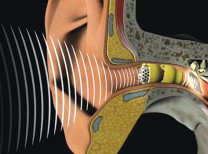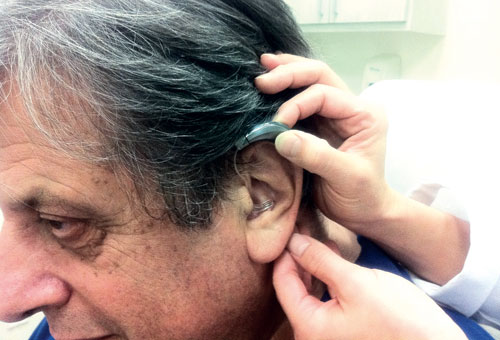Hearing loss is a major public health issue. It is the third most common chronic illness in the U.S, after arthritis and heart disease. So why does hearing loss often go untreated? In many cases, it occurs gradually, so individuals may not be aware of their hearing loss. This article, the second of a two-part discussion, presents some of the facts and misconceptions that are held about this chronic illness that affects 35 million Americans today.
MYTH #6: My hearing loss isn’t bad enough to require wearing a hearing aid.
FACT: Everyone’s hearing loss and listening needs are different. Some feel that even a mild loss is detrimental. For example, misunderstood conversation by a CEO in the boardroom can be costly. Other patients with mild losses simply enjoy the ability to hear better with correction. Conversely, some individuals with severe hearing loss may believe that it is not problematic, when in reality, it is causing significant communication difficulties, negatively impacting their familial relationships.
MYTH #7: Hearing loss is a harmless condition.
FACT: Untreated hearing loss has serious emotional, social and medical consequences. In a study reported in 2007, National Council on Aging surveyed 2,300 hearing-impaired adults over age 50. They found that those with untreated hearing loss were more likely to suffer depression, anxiety and paranoia, and were less likely to participate in organized social activities. Moreover, the study found that hearing aid users reported benefits in many areas of their lives, ranging from their relationships at home, sense of independence, improved social life, and sex lives.
FACT: Untreated hearing loss may increase the risk of developing dementia. A recent 2011 study, from Johns Hopkins University and the National Institute on Aging, demonstrated a significant link between hearing loss and dementia. This study evaluated 639 volunteers; hearing and cognitive abilities were tested and followed over a several year period. The researchers found that study participants with hearing loss at the beginning of the study were significantly more likely to develop dementia by the end. The more hearing loss they had, the higher their likelihood of developing the memory-robbing disease. Although speculative, it is possible that hearing aids may prevent against the development of dementia.
MYTH #8: Hearing aids are unattractive and will make me look handicapped.
FACT: Hearing aids are available in a variety of styles and colors. As a general rule, the size of the hearing aid correlates with the magnitude of the hearing loss. Individuals with mild hearing loss can be fit with tiny hearing aids that fit into the ear canal; however, a person with a severe hearing loss may require a larger aid that provides more power. Several options exist:
There are two different “invisible” aids that are placed deeply into the ear canal. One is a daily-wear aid, and the other is an extended-wear hearing aid. The daily wear hearing aid is placed so that it nearly touches the eardrum. The tiny aid is barely visible, and is removed by the wearer every day. In contrast, the extended-wear device is placed into the ear canal by the audiologist or physician, and is worn continuously for up to 4 months at a time. It is worn 24 hours a day, including when showering and sleeping, and requires no battery changes. Both of these devices are best for individuals with mild to moderate hearing loss.
For individuals with severe and severe-to-profound hearing loss, other “invisible” options exist. One is a semi-implantable device, MAXUM, by Ototronix. This system combines a magnet, surgically placed onto the hearing bones, and a processor worn deep in the ear canal. Another device is the inner ear stimulator, the Esteem, by Envoy Medical. It consists of a sound processor, implanted behind the ear, and two transducers that are implanted into the middle ear. Because all parts are surgically implanted, there are no externally visible parts.
These new options do not use a speaker to amplify sound. Instead, sound signals are transferred to the implant, which sends enhanced sound vibrations along the hearing bones, and naturally stimulate the inner ear. This provides clearer, crisper sound quality, and greater gain without feedback, compared to conventional hearing aids.
CONCLUSION: The FDA recommends that you see a physician if you have a hearing problem. Only a medical doctor (M.D.), can determine the cause of the hearing loss, and order additional tests, such as CT scans and MRI scans, if necessary.
An Otologist is a physician/surgeon specializing in hearing loss and diseases of the ear. The otologist will rule out infection, tumor, or other treatable causes of hearing loss. A comprehensive audiogram will be done by an audiologist. This is far more accurate and detailed than “free” hearing screening tests often offered to entice people into a hearing aid sale. Finally, if your physician recommends hearing aids, there can be significant health benefits to amplification. Several new options exist that offer improved cosmetics, greater clarity, and improved quality of life, and may even protect against dementia.
For part 1 of 2 of this editorial, visit deserthealthnews.com/2011/10/hearing-loss-and-hearing-aids-what-you-need-to-know-part-1-of-2/
Dr. Kato is the founder of The Ear Institute in Palm Desert. Her top priority is improving the quality of life of her patients. Dr. Kato can be reached at 760-565-3900.
References: National Information Center on Deafness and Other Communication Disorders; National Institutes of Health; National Council on Aging; the Marke Trak VIII Study by Sergei Kochkin, PhD, Lin F, et. al. Arch Neurol Feb 2011.











































Comments (0)